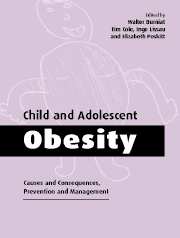Book contents
- Frontmatter
- Contents
- List of contributors
- Foreword
- Preface
- Part I Causes
- Part II Consequences
- Part III Prevention and management
- 12 Prevention
- 13 Home-based management
- 14 Dietary management
- 15 Management through activity
- 16 Psychotherapy
- 17 Drug therapy
- 18 Surgical treatment
- 19 Interdisciplinary outpatient management
- 20 Interdisciplinary residential management
- 21 The future
- Index
12 - Prevention
Published online by Cambridge University Press: 02 November 2009
- Frontmatter
- Contents
- List of contributors
- Foreword
- Preface
- Part I Causes
- Part II Consequences
- Part III Prevention and management
- 12 Prevention
- 13 Home-based management
- 14 Dietary management
- 15 Management through activity
- 16 Psychotherapy
- 17 Drug therapy
- 18 Surgical treatment
- 19 Interdisciplinary outpatient management
- 20 Interdisciplinary residential management
- 21 The future
- Index
Summary
Prevention before management
It seems almost de rigueur to end medical and nutritional texts with a section on prevention of the problem under discussion. Yet is this intelligent planning? The editors had lengthy discussions on the most logical order for the chapters in this book. No current programme for the treatment of obesity is particularly successful. Thus, control of the epidemic of obesity sweeping many countries in the developed world, and indeed beginning to affect countries in the developing world, is likely to depend more on effective prevention than on ‘cure’ of obesity. For this reason, priority in the management of childhood obesity has been given to this chapter on prevention.
Why prevention?
There are many reasons for promoting obesity prevention in childhood:
the prevalence of obesity is rising in industrialized countries (Chapter 2);
childhood obesity is likely to lead to obesity in adult life (Chapter 2);
it limits physical activity (Chapter 5);
it is associated with psychosocial disadvantage (Chapter 6);
it is associated with a higher risk of adult conditions such as Type II diabetes mellitus and hypertension (Chapters 7, 8, 10 and 11);
it is difficult to treat successfully (Chapters 13–20).
Primary prevention
The focus for preventive health programmes operates at three levels (WHO, 1998):
primary prevention, aimed at reducing the number of new cases (incidence);
secondary prevention, aimed at reducing the numbers of established cases (prevalence);
tertiary prevention, aimed at reducing the degree of disability associated with the condition (treatment).
- Type
- Chapter
- Information
- Child and Adolescent ObesityCauses and Consequences, Prevention and Management, pp. 243 - 269Publisher: Cambridge University PressPrint publication year: 2002
- 11
- Cited by



